

![]()
HERDING DOGS OF WESTERN EUROPE
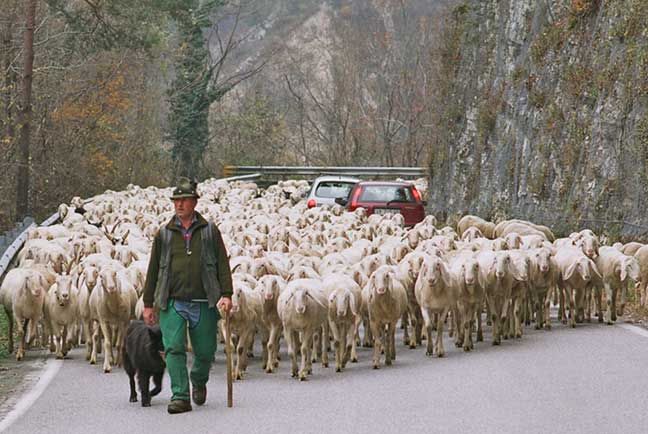
Shepherd Angelo Paterno, with dog and sheep along a road in the Eastern Italian Alps.
(Photo by Giancarlo Rado, reprinted with permission from the photographer.)
THE HERDING DOGS OF ITALY
After WWII, Italy quickly transformed from an agriculture-based economy into one of the world's most industrialized nations. Much of Italian livestock, particularly sheep, are in the Alpine region in the north, but in general, Italy is one of the Alpine countries with a relatively low livestock density. Old customs, such as transhumance in the Apennines (a range of mountains that runs the length of central Italy) are dying out, and wool production has almost completely disappeared. High altitude alpine pastures are still grazed in summer, and sheep are raised for milk and cheese, meat, and leather. Despite the decrease in agricultural persuits in recent decades, Italy has an amazing number of diverse herding dogs, many of which are getting a new lease on life due to a renewed interest by individuals or groups.
Bergamasco Shepherd Dog or Cane da Pastore Bergamasco
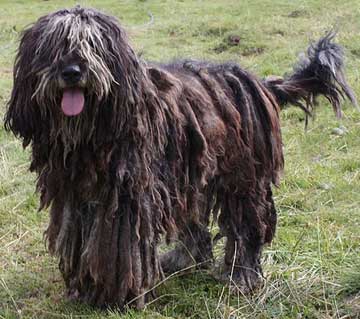 A Bergamasco on the Italian Alps. (Photo: Luigi Cavalchini, reprinted with permission.)
A Bergamasco on the Italian Alps. (Photo: Luigi Cavalchini, reprinted with permission.)
The Bergamasco has a long, continuously growing coat of three types of hair, that combine into a dense, felted mat to produce a corded or dreadlocked appearance. The coat was not only protection from weather and climate, but from attack of wolves and other dogs. The breed originated near Bergamo in Lombardy, in the foothills of the Italian Alps, when herding sheep was the primary economic resource of the area. There was a major decline in population when, after World War II, there was industrial expansion in the area and development of a tourist industry. After a long period of decline, enthusiasts were able to restore the breed. Today it is largely a show and performance dog.
The Bergamasco was used primarily for driving and guarding sheep herds. Proponents claim an ancient origin in the foothills of the Zagros Mountains between Iran and Iraq, when pastoral nomads, traveling west with flocks through Anatolia, Romania, Hungary and ultimately to the Alps, left dogs of its type in all the regions on the way. This may have been the case, as many breeds in these areas have qualities similar to the Bergamasco. However, again I must stress that it does not require common ancestry for development of common traits. One of the bigger breeds we are covering in this article, the Bergamasco is on the large side of medium, about 23 inches at the shoulder. There is an International Bergamasco Sheepdog Association (IBSA), which itself is not a member of the FCI, but the breed is recognized by the FCI.
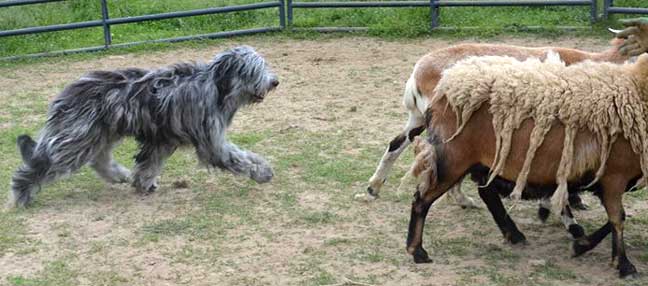 Right, a Bergamasco in training. (Photo from Windy Hill Bergamascos, by Susan Wyant.)
Right, a Bergamasco in training. (Photo from Windy Hill Bergamascos, by Susan Wyant.)
As a working dog, this breed has exceptional endurance capability. It is able to drive flocks long distances by wearing at the back of the flock. It works best for long periods of time at a consistent gait, without speed or sudden sprints, maintaining a long and smooth gait. It is built compactly and solidly for work in mountainous regions. Today, it is used primarily for herding cattle, the ones herding sheep considered "not pure" by the Bergamasco Sheepdog Association. These latter, however, may represent the original stock, now rejected for lack of conformation.
According to Michael Sing, a Representant of the IBSA from Switzerland: "With modern and industrial agriculture the field of work of all sheep dogs has changed also too, most of them lost their jobs in their original work. Today, many herds of sheep are unguarded (itŐs cheaper), large migratory herds are found only slightly. For herding, Border Collies are used primarily, for the protection of wolves Maremma Sheepdogs (Italy, Switzerland). However, in today's society most of the Bergamascos have found a place in other fields of work. There are some dogs which work very well in different sports disciplines and as search dogs. So you canŐt reduce the field of work of Bergamascos only on herding sheep and cattle. They are suitable for a lot of more and they work with joy!!! The most Bergamascos, like all other herding breeds, have no longer the task, as in earlier times. But they have integrated perfectly into new areas. Of course this depends always on the owner of the dog!"
Oropa Sheepdog or Cane di Oropa
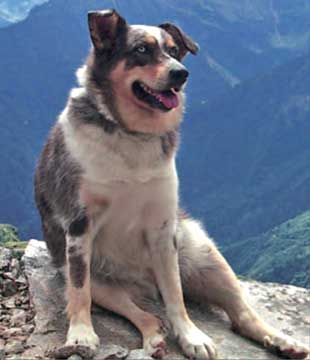
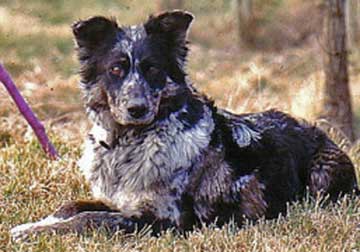 Left, a blue merle Oropa dog on the Western Italian Alps. (Photo courtesy of Dei Sentieri Del Biellese (The Paths of Biella), a tourist brochure.)
Left, a blue merle Oropa dog on the Western Italian Alps. (Photo courtesy of Dei Sentieri Del Biellese (The Paths of Biella), a tourist brochure.)
Right, an Oropa dog in the Italian Alps. (Photo: courtesy of Pastore Biellese, Cane di Oropa.)
This little-known herding dog has been used for centuries in the Biella region of the Western Italian Alps to herd indigenous cattle and sheep. Similar types are found throughout the Alps, in Eastern Italy, Switzerland, and possibly in France as well. Shepherd dogs of the Alps are not yet recognized by a kennel club or the FCI. They still come in a variety of coat-types, coat colors, ear carriages, weights and heights. If all types are classified under the name Oropa Sheepdog (a local name for a primarily merle-colored dog), it could spell the beginning of the end of diversity. The Oropa is currently the subject of a genetic study at the School of Veterinary Medicine, University of Milan. According to that study, the Oropa is genetically related to the Bergamasco and developed from hybridization with other breeds, including the Border Collie, which it resembles in looks more than it does the Bergamasco. Only a population of Oropa dogs is being studied, not examples from types elsewhere in the Alps, so it isn't known yet if other groups show the same relationships or come from the same stock. In fact, little is known whatsoever about these other Alpine shepherd dogs, and perhaps, as with the Bergamasco, once the Oropa is "recognized" under the all-encompassing name of Cane da Pastore delle Alpi or Shepherd Dog of the Alps, as it is known in the study, these other dogs will be dismissed as "not pure".
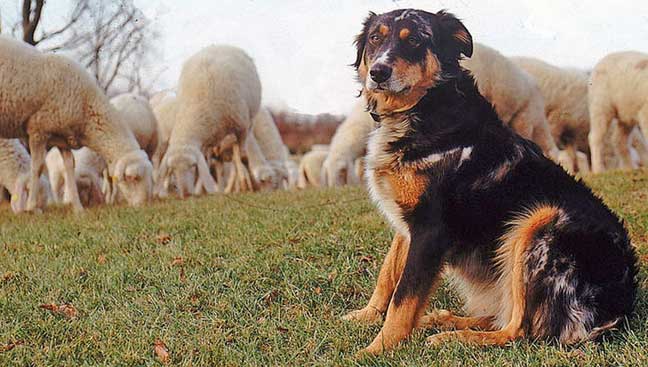 Right, an Oropa dog guarding a flock. (Photo: courtesy of Pastore Biellese via Stockdog Savvy blog, with permission from Jeanne-Joy Hartnagle-Taylor.)
Right, an Oropa dog guarding a flock. (Photo: courtesy of Pastore Biellese via Stockdog Savvy blog, with permission from Jeanne-Joy Hartnagle-Taylor.)
Merle or merle tricolor predominates in the Oropa and is preferred by local shepherds. Merle to merle breeding takes place, but it is claimed that no problems have arisen because of it. However, there are researchers, Pier Vittorio Molinario in particular, who think breeding merle to merle can be very dangerous (please see our page on merle for Molinarios thesis on the subject). However, according to Molinario, it was recently noticed that the MM, or double merle gene pair, does not produce the same effect in all breeds. Molinario posits that some groups of genes may be able to buffer or displace the MM pairs. Other solid colors do exist in the Oropa, such as black and shades of brown. Like the cattle and sheep that they herd and guard, the Oropa is a landrace, adapted to the harsh environment of the Alps and their foothills. It is a powerful dog with great stamina, intelligence, and willingness to work. Double dew claws on both front and back legs are not unusual, and may be common in, and advantageous to, all mountain dogs.
The Oropa was in danger of extinction by the 1950s due to the abandonment of many mountain farming communities and changing of livestock breeding practices. In the 1970s and '80s, Italy embarked upon a number of programs to protect their cultural and genetic resources and revive local agricultural traditions. This benefited both indigenous livestock and the dogs that herded them. In 2004, Friends of the Oropa Dog was formed to promote and stabilize the breed. A breeding program was developed, ostensibly to highlight working ability. A standard was also developed. According to their president, Pier Francesco Gasparetto, "all colours are permitted". Their ultimate goal seems to be seeking recognition by the FCI.
(All the following photos in this section are by Giancarlo Rado, and reprinted with permission from the photographer. They are of the herding dog in the Eastern Italian Alps described below.)
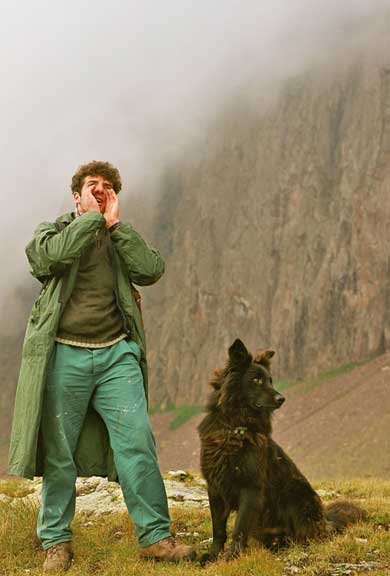
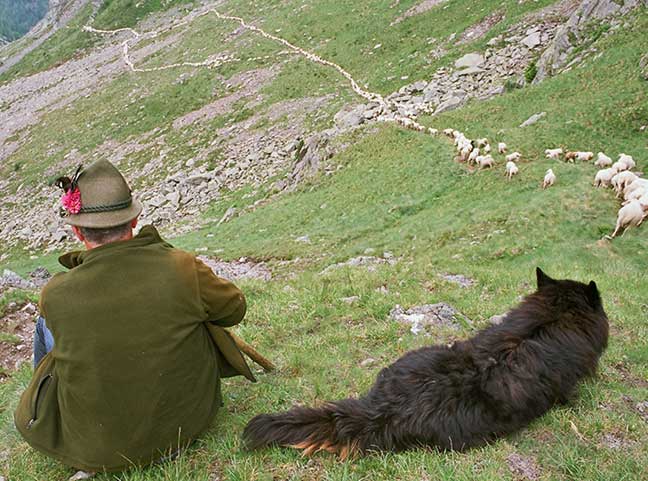 Left, shepherd Saverio Fontana calls commands to a dog while another waits at his feet.
Left, shepherd Saverio Fontana calls commands to a dog while another waits at his feet.
Right, shepherd Angelo Paterno and dogs resting on a slope as the sheep graze. Note the sheep strung out on the slope all the way into the upper left corner of the photograph, in what looks like a very far distance.
There is a type of herding dog in the Eastern Italian Alps very similar to the Oropa, which may in fact be closely related, though no DNA studies have been done on them. The shepherds in the Eastern Alps seem to prefer the solid colors, particularly black. From the photos it can be seen that when on the move, the shepherd leads and the dog goes either at his side or between him and the sheep. The strategy is probably that the presence of the dog keeps the sheep from surging forward, and the dog is available to dash to either side when necessary at the command of the shepherd. It is likely that the Oropa also works in this manner. It should not be assumed that these dogs cannot do an outrun and gather, because when the sheep are grazing they are often strung out in long lines far along the steep slopes. That's when shepherds and dogs rest. A gather would be necessary prior to moving to the next pasture.
Below, shepherd Giovanni about to go off with his dog and sheep in the Eastern Italian Alps.
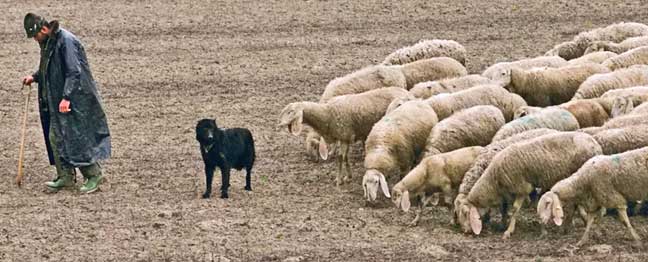
Italian Shepherd or Cane Paratore Italiano
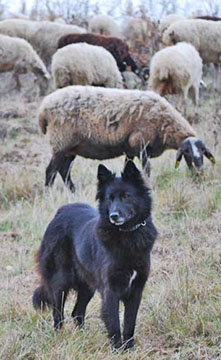
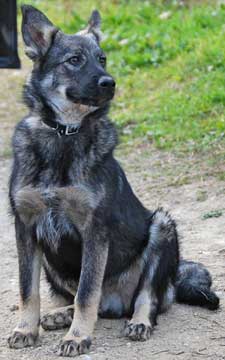
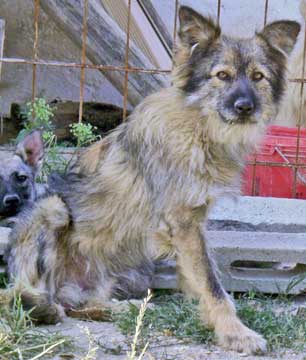 Left, a black Cane Paratore with his flock. (Photo courtesy of Asia Veleda.)
Left, a black Cane Paratore with his flock. (Photo courtesy of Asia Veleda.)
Right, two typical Paratores, Carbo (near right) and Dancing Wolf (far right). (Photo courtesy of Allevamento San Procolo.)
In Southern Italy, transhumance had been from the Tavoliere delle Puglie, a plain in the northeastern part of Southern Italy, to the Apennines pastures. The Apennines are a mountain range or chain of mountain ranges running the length of the peninsula of Italy. Transhumant flocks traveled grassy tracks similar to the drove roads of Scotland and Wales, that allowed the flocks to rest and graze during a journey that took as many as fifteen days. These treks were accompanied by a small to medium-sized herding dog, the Cane Paratore Italiano, also called "the dog of the moor".
The Paratore is an ancient race of herding dog that is traced to the wolf by advocates, and indeed, this type has a lupine look about it. It comes in wolf color (agouti or wild pattern) with a black mask, grey brindle, leopard (merle), black, sable, and tan. The Paratore has a hard, medium rough coat and is sometimes bearded, with a thick undercoat. The ears are erect or semi-erect. They have exceptional toughness, agility, stamina and strength. It is very diverse in looks and it is said that bitches in heat sometimes will mate with wolves and this is considered, by the Center for the Preservation of the Cane Paratoro, a "spontaneous restoration of blood lines". Although wolf researchers say that wolves and dogs do not spontaneously breed, it is not unheard of for men to facilitate such breedings. The connection to the wild may be a fact, as Paratores mature earlier than most of our modern breeds, are fiercely protective of their young, and have a proven immune system. In any case, they are definitely a landrace type. The Paratore works similarly to the Oropa.
Most of the transhumance in Italy today is in the north, so the Paratore is not well known and is endangered. For more information on the breed, please go to the website of the Centre for Preservation Breeding of Italian Working Dog Breeds, http://www.dicasamarziali.com/en/index.html
The Wolf Dog of Gigante or Cane Lupino del Gigante
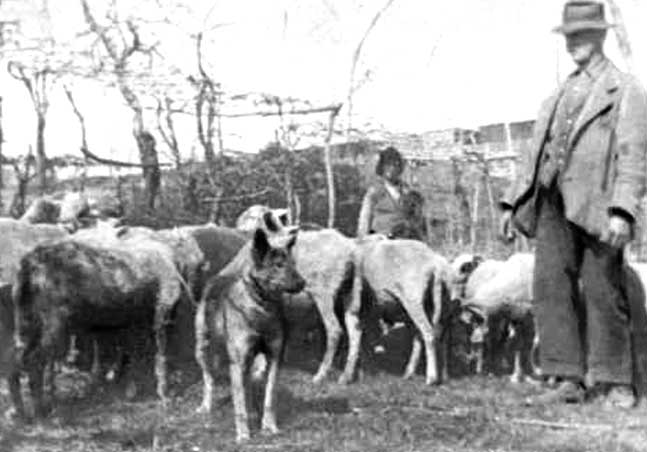 Right, a photo from the 1920s showing a shepherd and flock with a Cane Lupino del Gigante. (Photo from Cane Lupino del Gigante Associazione di Volontariato, with permission from The Staff of Allevamento di Fossombrone.)
Right, a photo from the 1920s showing a shepherd and flock with a Cane Lupino del Gigante. (Photo from Cane Lupino del Gigante Associazione di Volontariato, with permission from The Staff of Allevamento di Fossombrone.)
Monte Cusna is the tallest mountain of the northern Italian Apennines. It bears the nickname Gigante because from a distance it looks like a giant sleeping man. The use of shepherd's dogs to herd and guard the flocks in the Apennines dates back a thousand years and more. It is likely that this breed had similar roots to the Cane Paratore, above. The name "Luvin" or "Lupin" was used for herding dogs all over the Apennines, but in modern times, these dogs lost their numbers significantly due to disappearance of sheep and grazing and also from the introduction of other breeds. L'Associazione Cane Lupino del Gigante was formed to try to save this breed. They obtained the last remaining populations that took their names from four valleys, Lupin Ventasso, Lupin Val Bona, Lupin Costa de Grassi, and Lupin Val d'Asta and bred them together to form a new pure breed with a new name. Like with the Paratore, above, the Association credits their "lupine appearance" to actual crossing with wolves.
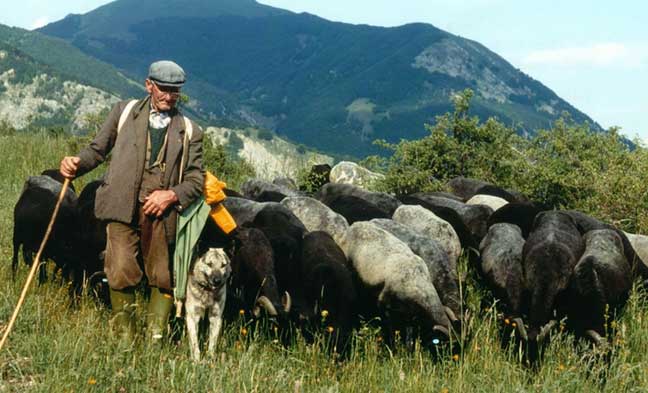 left, a photo from the 1990s of shepherd and flock with a modern Cane Lupino, which shows how little the breed has changed in more than seventy years. (Photo from Cane Lupino del Gigante Associazione di Volontariato (www.cane-luvin.eu), with permission from The Staff of Allevamento di Fossombrone (www.difossombrone.it/) and their website Le Razze Canine Italiane (www.razzeitaliane.it/).)
left, a photo from the 1990s of shepherd and flock with a modern Cane Lupino, which shows how little the breed has changed in more than seventy years. (Photo from Cane Lupino del Gigante Associazione di Volontariato (www.cane-luvin.eu), with permission from The Staff of Allevamento di Fossombrone (www.difossombrone.it/) and their website Le Razze Canine Italiane (www.razzeitaliane.it/).)
The standard was originally couched in more general terms than most pure breed standards, but it seems like a new standard has been put forward. It is a medium-sized dog. Pictures show grey- or tan-based sable, or brindle, with or without a light mask, or even white. The coat comes in both a rough or long-haired and smooth or short-haired variety. It is not currently an FCI recognized breed but it looks like this might change in the near future.
Valchiusella Shepherd Dog or Pastore della Valchiusella
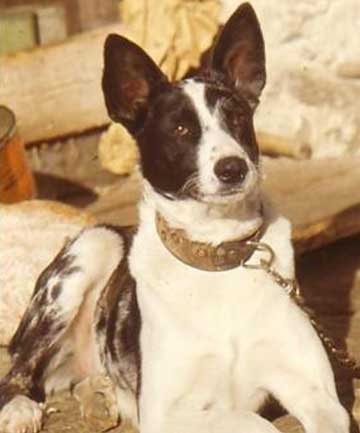
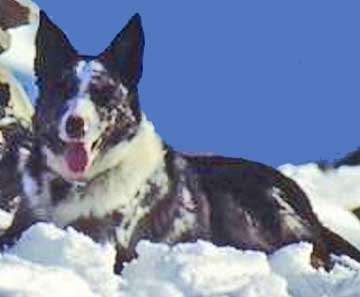 Left and right, blue merle Valchiusella Shepherd Dogs. (Photos courtesy of Pier Vittorio Molinario.)
Left and right, blue merle Valchiusella Shepherd Dogs. (Photos courtesy of Pier Vittorio Molinario.)
The Valchiusella comes from an area in the foothills of the Alps. It is a natural breed or landrace, one that has not been spoiled by human intervention. Pier Molinario believes that "The history of this breed is the same [as] that of the hundred[s] of local herd[ing] (and merle) dog breeds scattered from the Pyrenees [mountains] to [the] Caucasus, and probably no different from the history of British curs and collies: unknown in details but clear in selection and isolation mechanisms, like the history of local languages and ethnic populations." The farmers in the area maintain continuous breeding lines among small circles of relatives, friends, and neighbors. Crosses between different lines are mostly made by exchange of puppies, or, less frequently by borrowing studs for their bitches in heat. Good lines, says Molinario, "tend to last as long as the fame of their founders" and farmers are able to "rattle off without hesitation pedigrees of dogs that belonged to famous breeders and shepherds."
The difference in size between males and females of the Valchiusella can be fairly great, with males averaging 21 to 25 inches at the shoulder, and females averaging 19 to 23 inches. There are differences in ear carriage, hair length, length of the tail, and size, among different lines, but, Molinario says, coat and eye color "obey more complex hereditary mechanisms". Merle is common in this breed as it is in many of the Alpine breeds.
Stone Corner's Cattledogs or Pastore Collepietra
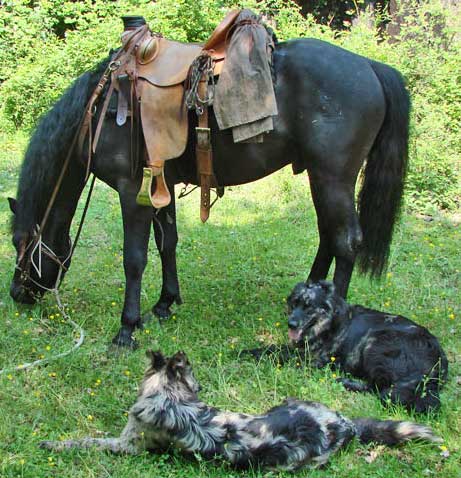 Left, two Stone Corner's Cattledogs waiting with their owner's horse. (Photo courtesy of Oswald Haller.)
Left, two Stone Corner's Cattledogs waiting with their owner's horse. (Photo courtesy of Oswald Haller.)
Worth a brief mention is another "sub-Alpine breed" known as the Stone Corner's Cattledog, "stone corner" being a rough translation of the word collepietra meaning stone hill, indicative of an area in the far northeast of Italy in the Dolomite Alps on the border with Austria. Actually, the area is more interesting than the dogs. Before WWI it belonged to Austria as part of the Austro-Hungarian Empire. People still speak a Tyrolean dialect along with Italian, and road signs are in both languages. People have retained their Germanic names, and the foremost breeder of these cattledogs is a man called Oswald Haller. The breed is only about twenty years old, formed when members of a local horse club decided to breed German Shepherd Dogs with indigenous sheepdogs, and stabilize the merle coat in the offspring. The dogs resemble most of the dogs throughout the Alpine region. The breeders have no ambition, thus far, for official recognition.
Italian Shepherd or Pastore Italiano
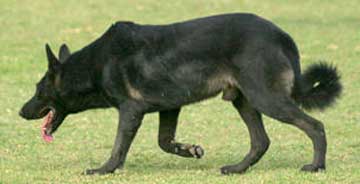
Above, a typical Pastore Italiano. (Photo courtesy of the Italiano Fan Club.)
Below left, two Pastore Italianos looking over sheep. (Photo courtesy of Marco Leona.) Below right, typical Pastore Italianos. (Photos courtesy of the Italiano Fan Club)
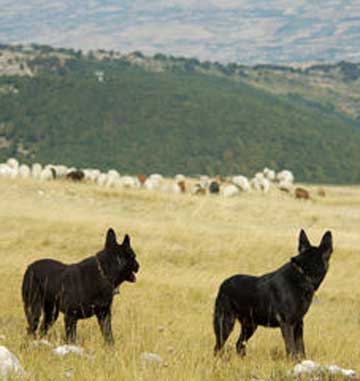
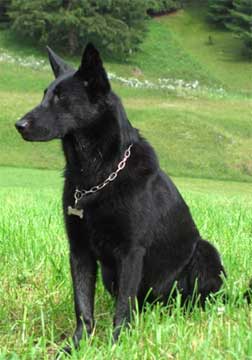 This is another new breed, formed in 1975 from black cattle dogs from the areas of Abruzzo, northern Lazio, Tuscany and Umbria, all more or less in central Italy. These dogs were called lupoid/molossian because they had traits similar to wolves, mastiffs, and molossers (see our glossary for the definitions of these terms). The resulting breed is medium-sized, but with a very great difference in size between the males (24 to 27 inches) and the females (21 to 22 inches). One could almost say that they were two different breeds, with the males outside of our discussion area! However, we thought they were at least worth mentioning. The organization that represents them, Pastoreitaliano Fan Club, have developed a very precise standard.
This is another new breed, formed in 1975 from black cattle dogs from the areas of Abruzzo, northern Lazio, Tuscany and Umbria, all more or less in central Italy. These dogs were called lupoid/molossian because they had traits similar to wolves, mastiffs, and molossers (see our glossary for the definitions of these terms). The resulting breed is medium-sized, but with a very great difference in size between the males (24 to 27 inches) and the females (21 to 22 inches). One could almost say that they were two different breeds, with the males outside of our discussion area! However, we thought they were at least worth mentioning. The organization that represents them, Pastoreitaliano Fan Club, have developed a very precise standard.
The Italian Shepherd can have a smooth or moderate rough coat with a dense undercoat. Black dominates, but other solid colors are allowed, and even merle. This breed is not yet recognized by the FCI, but that is probably only a matter of time. As a breed it is only in its third generation. There is no indication from the Fan Club's website that as a breed it is a working breed. Indeed the website calls it a utility dog, guard dog, and companion, much like the German Shepherd Dog. Are the cattle dogs that it evolved from still extant? That remains to be seen, and if I can find this information, we will definitely revisit this area.
Special thanks go to Piero Accettella, Alberto Bertelli, Prof. Luigi Cavalchini, Carla Cruz, Cristian Ielli, Dr. Stefano Marelli,
Pier Vittorio Molinario, Giancarlo Rado, and Lucio Rocco, for their invaluable help.
Copyright © 2013 by Carole L. Presberg
Resources:
Allevamento di Fossombrone, Sito Web Informativo Sulle Razze Canine Italiane (www.razzeitaliane.it/cani/main5_volpinoitaliano.htm).
Bertelli, Alberto. Department of Zoology, Parma University, Northern Italy, from private correspondence.
Cane Lupino del Gigante Associazione di Volontariato (www.cane-luvin.eu/).
Carea Leonés, Perro de Pastor (www.carealeones.blogspot.com/).
Carea Leonés, Perro de Pastor (on Facebook), includes two excellent videos of Careas working (www.facebook.com/pages/Carea-Leonés-Perro-de-Pastor/282240701841224).
Cavalchini, Prof. Luigi. Doctor of Veterinary Medicine, U. of Milan; current president, Bergamasco Club; past president, Italian Border Collie Club; past president, Italian Kennel Club. From private correspondence.
Cruz, Carla. Biologist, researcher, and kennel owner, from private correspondence.
Friends of the Cane di Oropa (http://canedioropa.jimdo.com/).
Gasparetto, Pier Francesco. President, Friends of the Pastore Biellese Cane di Oropa. From private correspondence.
Haller, Oswald. Stone Corner's Cattledogs (www.cattledogs.it).
Hartnagle-Taylor, Jeanne-Joy. Stockdog Savvy blog (www.stockdogsavvy.wordpress.com).
Ielli, Cristian. Allevamento di Fossombrone, "Il Cane Lupino del Gigante" (www.razzeitaliane.it/articoli/main36canelupinodelgigante.htm).
Marelli, Dr. Stefano Paolo. Department of Veterinary Medicine, U. of Milan. From private correspondence.
Marziali, Maurizio. Center for the Preservation of Italian Working Dog Breeds (http://www.dicasamarziali.com/en/index.html).
Molinario, Pier Vittorio. "Il cane pastore della Valchiusella" (www.valchiusella.org/flora-e-fauna/il-cane-pastore-della-valchiusella) and from personal correspondence.
Pastore Italiano Fan Club (www.pastoreitaliano.it/).
Wikipedia: "Cane di Oropa" http://en.wikipedia.org/wiki/Cane_Di_Oropa)
Wikipedia: "Carea Leoné (http://en.wikipedia.org/wiki/Carea_Leonés).
Return to
![]()
BORDER COLLIE COUSINS
THE OTHER WEB PAGES WE MAINTAIN
These web pages are copyright ©2013
and maintained by webmeistress Carole Presberg
with technical help from webwizard David Presberg
ALL RIGHTS RESERVED
If you are interested in using ANY material on this website, you MUST first ask for permission.